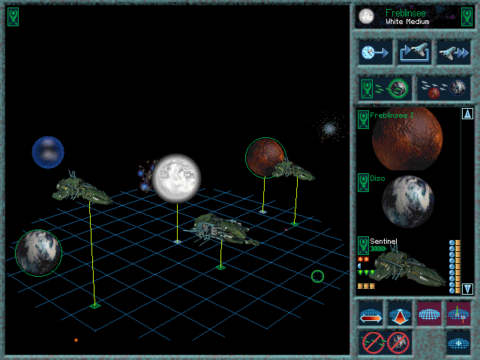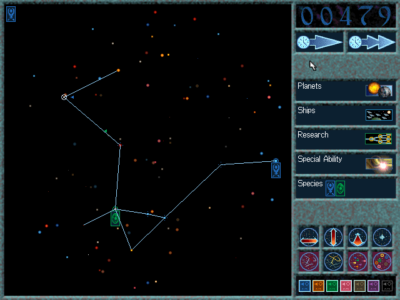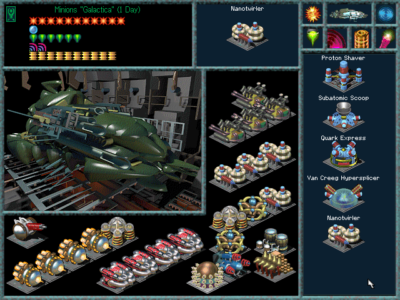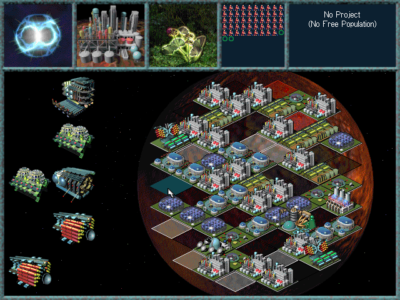
Ascendancy
Written by: Stoo
Date posted: June 1, 2001
- Genre: Strategy
- Developed by: The Logic Factory
- Published by:
- Year released: 1995
- Our score: 7
Ascendancy puts you in the position of ruler of your chosen race as they take their first tentative steps into space. It’s up to you to direct construction of ships, exploration and colonisation. You must also oversee population growth and the building of various structures on each world. When you run into aliens, it’s up to you to try a diplomatic relationship, or take a more warlike stance.
First, some praise for the straightforward and uncluttered interface. You can look at your empire from one of three levels of focus. Firstly, the galaxy is presented as a wonderful spinning-rotating 3D map. Each star is linked to one or more of its neighbours by starlanes. You can then click on any system you’ve explored. This takes you to a display of that system, again in 3D although ships and planets are represented with sprites. Clicking on a planet you own lets you get down to the details of administrating.
Each colony simply has three main outputs, produced by certain structures: Industry determines your rate of building structures and ships, prosperity controls birth rates, research is contributed to an overall figure and determines how fast you get your hands on new goodies. The available space on a planet is represented by a grid of squares, some of which offer bonuses to one of the above outputs, and building up a colony involves placing structures on this grid. That’s about all you need to know; there are no complex financial, economic or morale-related processes going on in the background to worry about. In fact there’s no concept of money or finite resources in the game at all, apart from the time your current industrial base needs to build something. Which means that while its easy to grasp the mechanics of running your empire, the game does in the long run feel a bit simplistic in this area.
Another minor flaw – there’s a lot of space to build on and no one structure does much by itself; they need to be built in numbers. You must therefore repeatedly tell each colony “build a factory, built a lab, build a farm, now another factory, now a lab, and another”. This stacks up as you found more colonies, until you find the game stopping every single turn to drag you through a list of finished projects and asking what you’d like to build next. Essentially what I’m trying to say is that a build queue would have been a very good idea. Oh, there is an auto-manager that offers to handle this for you, but its decision-making seems to be a bit questionable.
However, before worrying about such details you must pick the race you wish to lead. There’s a whole host to choose from: sentient fungi, nature spirits, floating trifles and more but sadly a lot of potential was wasted here. For one thing the only glimpse we see of the creatures themselves is a single portrait for each one; I would have liked to see a lot more of the weird and wonderful ideas Logic Factory cooked up. Also, there’s not many practical gameplay differences between the species, compared to the highly varied factions in games like Master of Orion 2 or Alpha Centauri. Each race has just a single unique ability, and that’s it; they do also have their own ship designs but the differences are purely cosmetic. Still, in the hands of the computer they do at least differ in attitude; some are friendly, some guarded isolationists, others rampant warmongers.
Unfortunately, the AI is not brilliant. Well, for a game of this age I’m not exactly expecting it to possess the wisdom of Sun-Tzu’s “Art of War” but this one does seem especially inept. The other races never really adopt a coherent strategy but rather expand aimlessly or send in uncoordinated attacks. It’s usually possible to run rings around them. What can also hinder AI races is their reluctance to decommission old technology. For example they fill up their colonies with basic factories and labs, but fail to later demolish these to make way for more advanced structures. The same problem often keeps alien fleet from being as potent as their technology allows. They tend to accumulate obsolete ships until they get ‘cleared out’ by a few battles, finally leaving space for bigger, better hardware.
A patch (called the Antagoniser) was later released to increase the challenge of the game, but it doesn’t seem to make the computer players much brighter. Instead, they get boosts to their productivity, and also become more hostile. Basically this is cheating, but it does add to the longevity of Ascendancy if you’ve found it a bit too easy.
One example of problems with AI and resource management is the limits on shipbuilding. You see, a simple limit of one ship per star-system controlled replaces any kind of maintenance cost. Which sounds nice and simple, until you realise that if two races own different planets within a system, neither can use that system to count towards their ship limit. It’s thus possible to destroy an enemy fleet simply by putting a colony on a spare planet (assuming one is available) in every system they control. The computer fails to recognise this as a hostile act and may not respond. This also works the other way, as the computer will happily settle planets in your own system as part of what it thinks is peaceful expansion.
Anyhow, there is a simple but reasonably solid diplomacy system for dealing with computer players. You can suggest trading info on star, systems, starlanes or technology (or they might initiate such a trade). Generally getting into a race’s good books involves much of such trading (it’s also a good idea to refrain from launching a blitzkrieg on their colonies). You may also be able to secure an alliance; friends are always useful even if they’re not too bright. What’s nice is when talking to allies, you can ask them to send warships to help you out in a conflict. You can also ask them to seek alliances with or declare war on other races, although the former option rarely seems to work.
Let’s move onto starships; interstellar battlecruisers are after all the most entertaining part of these games. What really redeems Ascendancy for me is designing your ships; there’s a dazzling array of technology to bolt onto the basic hull. Ship items fall into the categories of guns, shields, sensors, reactor, engines and miscellaneous. Again a lot of imagination has been used here. For example there’s guns that fling singularities and a whole range of devices using fictitious nanoenergon Physics. Okay, at the end of the day each gun just fires a different-looking projectile with a varying numerical damage, but all the background information adds a little originality. Meanwhile the miscellaneous category includes all kinds of weird and wonderful items, such as devices to double weapon range, physically repel all nearby ships, sacrifice hull mass for energy, disable enemy weapons and many more.
Your hand out orders to your ships in the star-system display. Here they you can colonise worlds, arrange ships to defend a world, bring them in to a planet for refitting and so on. It is also here that combat takes place, rather than the game flicking to a separate “combat arena” as many of these games do (more on combat itself in a second). To move your ships to another system you must send them into the mouth of a starlane. Whilst in a lane they’re in a kind of limbo and cannot do anything until they emerge several game-days later at their destination. Starlanes come in two flavours; regular blue and the longer, slower red links. Generally the galaxy tends to be divided into a number of neighbourhoods of blue-linked worlds, with each neighbourhood joined to others by the red-links. The network of starlanes traces out quite a complex web across the galaxy, and two systems that seem close may require quite a tortuous journey to get from one to the other. This can be a little frustrating at first, but does force you to think carefully about where you position your fleets, rather than having them conveniently warp over to a trouble spot.
Returning to the system display: How much a ship can do in a single turn depends on action points determined by reactor output. However, unlike most turn-based games, each player with ships present takes it in turns to move a single craft, or fire a single weapon. It’s a matter of opinion as to whether this is fairer than the system used in Master of Orion 2, where one player moves and fires with all his ships at once, then the opponent takes their turn. In Ascendancy it’s near-impossible to move your fleet as a coherent unit, but at least you have a fighting chance to inflict some damage or run away if outnumbered and out gunned.
As an aside, unlike in MOO2, orbital planetary defences in the form of shields and cannon can be built up to truly formidable levels. This forces a major effort on the part of the attacker to capture that world, even if a defending fleet isn’t present.
Before wrapping up this review I feel I should make a mention for the music. There are some sweeping and soaring sequences that suit the “epic struggles between the stars” theme quite well. It’s definitely a step up from the kind of pleasing-but-uninspiring ambient stuff we normally get in these games. Each race also has their own atmospheric piece of music to fit their nature – it’s a shame these are so short. Sound effects meanwhile are fairly functional – there’s an irritating chime to accompany each mouse click but of course it can be silenced.
To summarise, Ascendancy was hindered from reaching true classic status by a couple of significant flaws: in short your opponents could be outwitted by a woodlouse, and it’s also true that there aren’t enough practical differences between the races. It’s also arguable that resource-management is too simplistic. However this remains a commendable example of interstellar empire-building. I’d recommend it to anyone with an interest in this kind of strategy, even if its not quite in the top league of such games.





 Posts
Posts